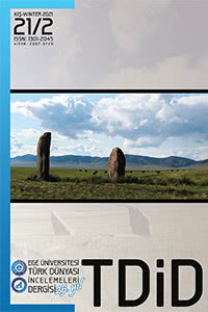Hunlar ve Xıongnu*
Huns and Xıongnu
___
- ALRAM M. [1996]. "Alchonund Nezak. Zur Geschichtederiranischen Hunnen in Mittelasien", La Persia e l'Asia Centrale da Alessandro Magno al X secolo, (Attidei Convegni Lincei, 127), Roma, ss. 519-554.
- ALRAM M. [2002]. "A Rare Hunnish Coin Type", Silk Road Art and Archaeology, vol. 8, ss. 149-153.
- AMMIEN Marcellin [1968-1977]. Histoire, Paris: LesBellesLettres.
- BAILEY H. W. [1954]. "Harahuna", Asiatica. Festschrift Friedrich Weller. Zum 65. Geburtstaggewidmet, Leipzig, ss. 12-21.
- BAILEY H. W. [1985]. Indo-Scythian Studies being Khotanese texts, VII, Cambridge: Cambridge University Press.
- BURJAKOV Ju. F. [1991]. "A propos de l'histoire de la culture de la région de Tashkent au 1er millénaire avant notre ère et au Ier millénaire de notre ère", Histoire et cultes de l'Asie centrale préislamique: Sources écrites et documents archéologiques, ed. P. Bernard, F. Grenet (éd.), Paris: CNRS, ss. 197-204.
- CHAVANNES E. [1905]. "Les Pays d'Occident d'après le Wei Lio", T'oung Pao, série II vol. VI, ss. 519- 571.
- DAFFİNÀ P. [1969]. "Chih-chih Shan-YO", Rivistadegli StudiO rientali, vol. XLIV-3, ss. 199-232.
- DAFFİNÀ P. [1994]. "Stato presente le prospettive della questione unnica", Attila. Flagellumdei?,ed. S. Blason Scarel Roma: Studia Historica, ss. 5-17.
- ENOKI K. [1955]. "Sogdiana and the Hsiungnu", Central Asiatic Journal, vol. 1, ss. 43-62.
- ERDY M. [1994]. "An Overview of the Xiongnu Type Cauldron Finds of Eurasia in Three Media, with Historical Observations", Archaeology of the steppes, ed. B. Genito, Napoli, ss. 379-438.
- GRENET F. [1989]. "Les 'Huns' dans les documents sogdiens du mont Mugh", Etudes Irano-aryennes offertes à Gilbert Lazard, (Cahier de StudiaIranica, 7), ss. 165-184.
- GRENET F. [1996]. "Crise et sortie de crise en Bactriane-Sogdiane aux IVe-Ve s. de n.e.: de l'héritage antique a l'adoption de modelés sassanides", La Persia e l'Asia Centrale da Alessandro al X secolo, (Atti dei Convegni Lincei, 127), Roma, ss.367-390.
- GRENET F. [2002]. "Regional Interaction in Central Asia and North-West India in the Kida rite and Hephtalite Period", Indo-Iranian Languages and Peoples, (Proceedings of the British Academy 116), ed. N. Sims- Williams, London, ss. 203-224.
- HENNING W. B. [1948]. "The Date of the Sogdian Ancient Letters", Bulletin of the School of Oriental and African Studies, vol. XII3/4,ss. 601-615.
- HEWSEN R. H. [1992]. The Geography of Ananias of Sirak (ASXARHAC'OYC'). The Long and the Short Recensions, (Beiheftezum Tübinger Atlas des Vorderen Orients, ReiheB (Geisteswissenschaften), 77), Wiesbaden: Reichart.
- DE LA VAISSIERE E. [2002]. Histoire des marchands sogdi ens, (Memoires de II'HEC, 32), Paris.
- DE LA VAISSIERE E.-RIBOUD, P. [2003]. "Les livres des Sogdi ens", Studia Iranica, vol. 32-1, ss. 127-136.
- LEVINA L. M., Etnokul'turnajaistorija Yostocnogo Priaral'ja.I tysjaceletie do n.e.-I tysjaceletie n. e.,Moscow: Vostocnaja Literatura RAN
- LEVY S. [1905]. "Notes chinoises sur l'Inde. V Quelques documents sur le bouddhisme indien dans l'Asie centrale", Bulletin de l'Ecole Françoise d'Extrême-Orient, vol. V,ss. 253-305.
- MAENCHEN-HELFEN O. [1944-45]. "Hunsand Hsiung-nu", Byzantion, vol. 17, ss.222-243.
- MAENCHEN-HELFEN O. [1955]. "Pseudo-Huns", Central AsiaticJournal, vol. 1, ss. 101-6.
- MAENCHEN-HELFEN O. [1961]. "Names of the Hiung-nu",Central Asiatic Journal, vol. 6, ss. 249-261.
- MAENCHEN-HELFEN O. [1973]. The World of the Huns. Studies in Their History and Culture, Berkeley: University of California Press.
- MARSHAK B.,RASPOPOVA, V. [1990]. "Les nomades et la Sogdiane", Nomades et sedentaires en Asie centrale. Apports de l'archeologie et de l'ethnologie, ed. H.-P. Francfort, Paris: CNRS, ss. 179-185.
- PARLATO S. [1996]. "Successo euroasiatico dell'etnico 'Unni'", La Persia e l'Asia Centrale da Alessandro al X secolo, (Atti dei Convegni Lincei, 127), Roma, ss. 555-66.
- PROCOPE [1914]. Histoire des guerres: The History of the Wars, I, ed.-terc. H. B. Dewing, Cambridge: Harvard University Press.
- SEDOV A. V. [1987]. Kobadiannaprorogerannegosrednevekov'ja (KobadianauseuilduHautMoyen-Age), Moscou :Nauka.
- SEMENOV G. L. [1989]. "Sogdijskijgorodv rannemsrednevekov'e: formirovanie plana", Itogirabotarxeologiceskixekspedicij Gosudarstvennogo Ermitaza, ed. G. Smirnova Leningrad, ss. 128- 140.
- SHIRATORI K. [1928]. "A Studyof Su-t'e, or Sogdiana", Memoirs of the Research Department of the Toyo Bunko, vol. 2, ss. 81-145.
- SIMS-WILLIAMS N. [1989-1992]. Sogdian and other Iranian Inscriptions of the Upper Indus, I-II, (Corpus Inscriptionum Iranicarum, II/III), London: School of Orientaland African Studies.
- SIMS-WILLIAMS N. [1997]. New Light on ancient Afghanistan. The Decipherment of Bactrian, London: School of Oriental & African Studies.
- SIMS-WILLIAMS N. [2002]. "Ancient Afghanistan and its Invaders: linguistic evidence from the Bactrian documents and inscriptions", Indo-Iranian Languages and Peoples, (Proceedings of the British Academy, 116), ed. N. Sims-Williams, Londres, ss. 225-242.
- SINOR D. [1990]. "The Hun Period", Cambridge History of Early Inner Asia, ed. D. Sinor, Cambridge, ss.177-205.
- TONGDIAN [1995]. par DuYou, Changsha, Yuelushushe.
- WEI SHU [1974]. par WeiShou, Zhonghuashuju, Beijing.
- YÜ, Ying-shih [1990]. "TheHsiung-nu", Cambridge History of Early Inner Asia, ed. D. Sinor, Cambridge, ss. 118-149.
- ZEIMAL' E. V. [1983]. "The Political History of Transoxiana", Cambridge History Of Iran, 3/1: The Seleucid, Parthian and Sasanian Periods, Cambrige: Cambrige University Press, ss. 232-262.
- ZURCHER E. [1972]. The Buddhist Conquest of China, (Sinica Leidensia, XI), 2 vol., 2. Ed. Leiden: Brill.
- ISSN: 1301-2045
- Başlangıç: 1996
- Yayıncı: Ege Üniversitesi Türk Dünyası Araştırmaları Enstitüsü
Türk Dünyası İncelemeleri Dergisi/Journal of Turkish World Studies 16/1 Yaz-Summer 2016
Sosgertli Âşık Mehmet Hicrani'ye Ait Derlenmemiş Bir Defter: Vatanım İçin
20. Yılında Türk Dünyası İncelemeleri Dergisi
Araş. Gör. Ali BALCI, Araş. Gör. Gökçe EMEÇ, Araş. Gör. Umut ÜREN
"Ancak" ve "Yalnız" Kelimeleri Üzerine
Doç. Dr. Arzu Sema ERTANE BAYDAR
"Dirse Han Oglı Bogaç Han Boyı"ndaki "Göl Gibi Kımız Sagdur-" İfadesi Üzerine
Sabahattin Ali ve Abdulla Kahhar Öykülerinde Dönem Meselesi
Mehmet Ziya Binler, Türk Dünyası Aile ve Akrabalık Terimleri Sözlüğü, Selenge Yayınları, Ankara-2007
"Dirse Han Oglı Bogaç Han Boyı"ndaki "Göl Gibi Kımız Sagdur-" İfadesi Üzerine
Bitmeyen Bir Tartışmaya Edebiyatçıların Bakışı: "Dil Öğretiminde Gramere Lüzum Var mı?"
